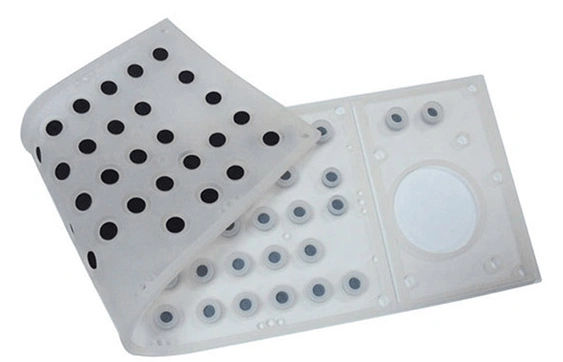Characteristics and Uses of Silicone
Silicone is a type of rubber. After vulcanization, silicone rubber exhibits excellent resistance to heat, cold, ozone, and atmospheric aging, as well as good electrical insulation properties.
However, silicone rubber has certain disadvantages, such as lower tensile strength, lower elongation at break, and higher compression set.
It is suitable for manufacturing parts that need to withstand high and low temperatures, sunlight, atmospheric exposure, and ozone, as well as for electrical insulation components.
Dimensional Precision and Recommended Tolerances
Silicone keypads are made from elastomeric materials. Compared to plastic materials, their shrinkage rate is influenced by multiple complex factors, making it more challenging to achieve high precision. In design, high precision should not be required in critical areas.
If the basic dimensions are too large to meet the required precision, a positioning post with a deformed baseplate can be used to adjust the fit. In areas where dimensional accuracy is necessary, allowances should be made for mold adjustments.
Etching of Text and Patterns
Logos and text can be designed on the silicone substrate and molded simultaneously during the manufacturing process. The markings and text on the product can be either embossed or recessed. To facilitate mold processing, they are generally designed as embossed.
To simplify the replacement of markings or model numbers, the marking section of the mold can be designed as an insert. When the product model changes, replacing the insert in the mold cavity will suffice. In designing these components, it is acceptable to allow minor flash residue at the insert junctions.
Key Travel and Structural Considerations
For conductive rubber keypads, the typical key travel is 0.8–1.5 mm. A vent slot (air hole) is designed to prevent suction effects between the keypad and the PCB during operation.
For tactile switches, the key travel depends on the switch’s own stroke (and any misoperation prevention stroke), as described later. If the silicone substrate is not in direct contact with the PCB, the air slot can be omitted.
Keypad design should consider tactile feedback. Different force-travel curves result in different tactile sensations. Based on experience, a force ratio of (FP-FC)/FP between 40% and 60% provides an optimal feel.
Typical Keypad Structures and Applications
Depending on the specific application, as well as requirements for lifespan, actuation force, and tactile feedback, silicone keypad structures and applications vary, as shown in the diagram.
The lifespan of silicone keypads is directly related to the material and sloped-wall design, and it should be determined based on design needs.
Reference lifespans for silicone keypads in different products:
- Remote controls: 500,000 cycles
- Telephones: 1,000,000 cycles
- Laptops: 4,000,000–5,000,000 cycles
- Computer keyboards: 5,000,000–10,000,000 cycles
- Medical monitoring devices: ≥500,000 cycles
- Ultrasound machines: ≥1,000,000 cycles
